Babes in Arms
Musical (1937)
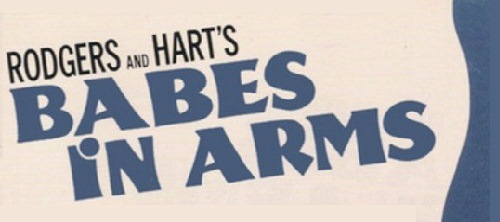
Babes in Arms est un musical de «passage à l'âge adulte» créée en 1937 avec une musique de Richard Rodgers, des paroles de Lorenz Hart et un livret de Rodgers et Hart. Il s'agit d'un groupe d'adolescents d'une petite ville de Long Island qui organisent un spectacle pour éviter d'être envoyés dans une ferme de travail par le shérif de la ville lorsque leurs parents acteurs partent sur la route pendant cinq mois dans le but de gagner de l'argent en faisant revivre le Vaudeville.
Broadway 1937
Babes in Arms a ouvert à Broadway au Shubert Theatre le 14 avril 1937, a été transféré au Majestic Theatre le 25 octobre 1937 et a fermé le 18 décembre 1937 après 289 représentations.
Malgré des critiques élogieuses lors de la soirée d’ouverture, les grand public a montré peu d’intérêt pour Babes In Arms, peut-être à cause du verdict rendu par le journaliste de Variety lors des Ry-Out: «Pas de nudité, pas de show girls, pas de poupée peut signifier pas de vente». Une «mise-à-mort» assez semblable reviendra pour le premier spectacle de Rodgers et Hammerstein, Oklahoma! () quelques années plus tard. En avril et en mai, les recettes étaient à peu près égales, parfois inférieures.
En juin, Wiman a diminué le billet principal de cinquante cents, mais les ventes ont continué à baisser. Puis tout à la fois, comme par une intervention divine, chaque spectacle concurrent sur Broadway s'est arrêté. Le 17 juillet, Babes in Arms est devenu le seul musical à Broadway. Les recettes de la semaine suivante ont bondi de 50%; après cela, le spectacle n’a jamais faibli.
Un revival?
Il est intéressant de s'attarder sur le revival du Babes In Arms de Rodgers and Hart . Il n’a jamais été tout à fait ce que l'on croit qu'il a été. Babes in Arms a été le succès de la saison quand il a ouvert en 1937 – malgré un lent démarrage – avec près de 300 représentations. Mais cette œuvre a virtuellement disparu par la suite. Il faut dire que globalement, peu de considération a été accordée à la préservation des musicals dans les années '30; un spectacle – succès ou échec – disparaissait pour faire place au suivant. Entre 1934 et 1940, Rodgers et Hart ont écrit 9 musicals à Broadway et quatre musiques de films, il n’y avait donc pas beaucoup de temps pour regarder en arrière. La plupart d’entre nous ont été découvert Babes In Arms par le film de 1939, qui n’a en fait conservé que le titre et deux chansons de l’original de Broadway. Il faut dire que la version originale avait une forte connotation politique avec des discussions sur Nietzsche, un personnage communiste, et deux jeunes afro-américains victimes de racisme.
À la fin des années '50, sous la supervision de Richard Rodgers, un livret entièrement nouveau a été écrit par George Oppenheimer avec les chansons réorganisées. Cette version a été créée au Royal Poinciana Playhouse de Palm Beach, avec Julie Wilson. Depuis lors, c'est cette version qui a été jouée.
Bien sûr, plusieurs tentatives ont été faites pour retravailler le livret original dans une version plus contemporaine que celle des années '30, mais ont échoué ou n’ont jamais vu le jour.
Cette révision est devenue le script sous licence officielle présenté au fil des décennies. Bénéficiant de l'une des meilleures partitions de l'âge d'or de Broadway, Babes in Arms a connu du succès dans des lieux aussi prestigieux que le Goodspeed Opera House (avec Andrea McArdle) en 1979, City Center en 1999 et dans d'innombrables lycées, collèges et théâtres régionaux à travers le pays.
Un groupe d’adolescents, dont les parents sont sont des acteurs de Vaudeville, mettent en scène une revue pour éviter d’être envoyé travailler dans une ferme. Malheureusement, le spectacle est un échec. Plus tard, quand un pilote français transatlantique atterrit à proximité, ils sont en mesure d’attirer assez de publicité pour monter sur un spectacle réussi et construire leur propre centre de la jeunesse.
Afficher le synopsis détaillé
Acte I
At the loss-making Surf and Sand Playhouse in Cape Cod, introduced to us by a jaundiced Press Agent Seating capacity 640, number of spectators per night 14, a group of young apprentices complain of their exploitation by the owner Seymour Fleming, who is even threatening to cancel their own planned revue. Their leader Valentine (Val) White has written a song about it. They are determined to do the show for the sake of the theatre's down-trodden co-owner Bunny Byron, who has to work for Fleming because of the money her father owed him. Terry and Gus have a love-hate relationship, not improved when Terry tries flirting with Lee Calhoun, the insufferable author of The Deep North, the play in rehearsal.
Val falls for the glamorous Jennifer Owen, the juvenile lead in the play, and his feelings are soon reciprocated. She sneaks away from her dominant mother Phyllis to watch Val rehearsing the revue. A passionate embrace is interrupted by young Susie, who is crazy about Val and jealous of the glamorous arrival. Val sees Susie as a younger-sister type, but for her he is "My Funny Valentine."
Jennifer can't stand Lee's play, his writing or his hammy acting and threatens to quit, but Phyllis imperiously solves the issue: a second week's run of the play, the first to count as rehearsals and no time at all left for the apprentices' revue. Jennifer backs down, but the kids and Bunny - are going to fight it all the way
Acte II
At the start, the Press Agent indicates a mood of depression and resignation among the kids: Susie alone is optimistic, but Val is upset that Jennifer has let them down. Lee arrives, hunting for Jennifer, who has slipped the leash again - the kids inveigle him into the cellar and lock him in, but he escapes, only to overhear Jennifer, who has come to tell the kids that she is planning to fake sickness to get out of the play and he slinks off to tell Fleming.
Phyllis, also looking for Jennifer, dramatically accuses Bunny of not being a lady for refusing to help search, which Bunny cheerfully admits. Fleming announces that the boy-wonder producer Steve Edwards (who is known to 'have a thing' for Jennifer) is coming to see the play, whereupon Susie and Terry hatch separate plans ..........
In Steve's hotel room, both girls are caught by Gus, who bundles Terry out, but Val gets a shock when he bursts in on Steve and Susie - not realising that they are brother and sister (and they're not telling yet!) He leaves in righteous fury, which delights Susie - but uppermost in her mind is getting her brother to see the revue.
The apprentices mischievously succeed in turning The Deep North into a shambles of miscued entrances, sound effects and collapsing props, and sneak off to the barn to do the revue, where Steve joins them. Of course, Fleming finds them, but is out of time in firing them all, as Steve has just handed them a cheque to option their show, so Fleming gets the debt paid off, Val and Susie are reunited - as the Press Agent says at curtain "A musical comedy can have a happy ending!"
Différentes versions de l'oeuvre
Babes in Arms (Guare Version)
La version 1937 de Babes in Arms de Rodgers & Hart est la quintessence du slogan Hey, kids, let’s put on a show! (LA phrase mythique de Mickey Rooney dite à Judy Garland dans un certain nombre de films de l'époque de la depression des années '30), avec une des plus grandes partitions jamais écrites. Un groupe d’adolescents sont laissés sans surveillance adulte quand leurs parents travaillent dans les tournées d’été de Vaudeville, et le shérif local est déterminé à envoyer les jeunes dans une ferme de travail. Mais les gosses déterminés incitent le shérif à un sursis de deux semaines, juste assez de temps pour produire leur propre spectacle et prouver leur courage. Le fils d’un riche sudiste accepte de financer la production mais seulement à la condition que les deux enfants noirs (rôles créés par les légendaires Nicholas Brothers) n’apparaissent pas dans la série. Les autres enfants sont outrés, mais bien sûr le spectacle doit continuer et le fait, dans une succession de déchirures, de réconciliations et de romances. Les vertus démodées d’une comédie musicale des années '30 sont parsemées de questions socio-politiques qui résonnent depuis plus de six décennies, et qui plus tard sont devenues la marque de la collaboration de Rodgers avec Hammerstein. Mais c’est la jovialité sophistiquée qui rend ses comédies musicales écrites par Hart totalement uniques, propulsant ces jeunes talentueux dans la découverte d'eux-mêmes à cette période si particulière qu'est l'adolescence.
Babes in Arms (Oppenheimer Version)
Situé dans un théâtre d’été, l’intrigue concerne un groupe de jeunes apprentis et leur combat pour monter la revue originale qu’ils ont créé tout en esquivant les tentatives sournoises du propriétaire du théâtre d'écraser leurs efforts dès que ^possible. D’autres complications sont fournies par la mère autoritaire d’une ex-enfant star et l’ego gonflé d’un dramaturge sudiste. Mais bien sûr, le spectacle doit continuer et le fait, dans une succession de déchirures, de réconciliations et de romances.
Acte I
“Where or When” (Mitzi Green, Ray Heatherton)
“Babes in Arms” (Mitzi Green, Ray Heatherton, Alfred Drake, The Gang)
“I Wish I Were in Love Again” (Grace McDonald, Rolly Pickert)
“All Dark People” (Harold Nicholas, Fayard Nicholas)
“Way Out West” (Wynn Murray, Alex Courtney, Clifton Darling, James Gillis, Robert Rounseville)
“My Funny Valentine” (Mitzi Green)
“Johnny One-Note” (The Singer: Wynn Murray; The Child: Dou- glas Perry; The High Priest: Alfred Drake; The Priestess: Elenore Tennis; The Nubians: Harold Nicholas and Fayard Nicholas; The Acrobat: Bobby Lane; The Specialty Dancers: Mitzi Green and Duke McHale; The Gang)
Acte II
“Imagine” (Wynn Murray, Alex Courtney, Clifton Darling, James Gillis, Robert Rounseville)
“All at Once” (Mitzi Green, Ray Heatherton)
Ballet: “Peter’s Journey” (the ballet also includes two reprises of “Imagine,” sung by Duke McHale) (The Prince: Duke McHale; The Prince’s Attendants: Kenneth Wilkins and LeRoy James; Rockefeller: Rolly Pickert; The Mermaid: Elenore Tennis; Greta Garbo: Gedda Perry; Marlene Dietrich: Ursula Seiler; Clark Gable: Ted Gary; The Gang)
“The Lady Is a Tramp” (Mitzi Green)
“You Are So Fair” (Grace McDonald, Ray McDonald, Ted Gary, Mitzi Dahl, Duke McHale, Jean Owens)
Finale (Company)
THE PRESS AGENT - Introduces us to the theatre, the company and to the revue at the close of the show.
TERRY THOMPSON - Young apprentice who is sexy and tries a heavy seduction routine on first Lee Calhoun and then Steve, as though she were a mature woman - but she is still a kid in her affections toward Gus.
GUS FIELDING - A clumsy, daffy but endearing apprentice, who is a naive, romantic kid in Terry's eyes.
PETER, BETTY, BOB, LIBBY, ANN, DON, NANCY - Young starry-eyed apprentices who work in terrible conditions for the love of the theatre.
VALENTINE WHITE - Mature, responsible apprentice, to whom the others look up, and not just because he has written and composed their revue. He is very attractive to the girls and though dazzled by Jennifer, he eventually realises that Susie is his real love.
SUSIE WARD - A young apprentice who is totally devoted to Val. She idolises him in a real younger-sister way. But the optimism and determination with which she succeeds in getting the revue performed proves she has a very mature side, which eventually wins Val over.
SEYMOUR FLEMING - A hard-hearted, penny-pinching man who makes enemies easily, while trying to ingratiate himself with important people.
BUNNY BYRON - A mousy lady who is pushed around by Fleming but very popular with the kids and secretly harbours ambitions to act and generally 'let rip'.
LEE CALHOUN - A small-town Southern playwright who is alone in thinking a lot of himself. He hams his way through everything and alienates everybody with his conceit.
JENNIFER OWEN - Beautiful young actress, ex-child movie star, she is smothered by her mother and fights for the time and space to be herself - preferably in male company.
PHYLLIS OWEN - A real 'stage mum' living her life through her daughter, while totally disregarding her. She herself is a melodramatic actress, often faking sickness to get sympathy and her own way.
STEVE EDWARDS - A young producer who uses his great charm to full effect. The brother of Susie, he has an open heart and is very supportive of the revue.
Aucun dossier informatif complémentaire concernant Babes in Arms
Aucun dossier informatif complémentaire concernant Babes in Arms
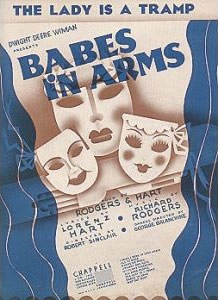
Version 1
Babes in Arms (1937-04-Broadway Run)
Type de série: OriginalThéâtre: Broadway Run (Broadway - Etats-Unis)Durée : 8 mois 1 semaine Nombre : 289 représentationsPremière Preview : 14 April 1937
Première: 14 April 1937
Dernière: 18 December 1937Mise en scène : Robert B Sinclair • Chorégraphie : George Balanchine • Producteur : Star(s) : Avec: Ethel Intropidi (Maizie LaMar), Jere Delaney (Dan LaMar), Ray Heatherton (Val, aka Valentine, LaMar), George E. Mackay (Nat Blackstone), Alfred Drake (Marshall Blackstone), Mitzi Green (Billie Smith), George Watts (Sheriff Reynolds), Rolly Pickert (Gus Fielding), Kenneth Wilkins (Booker Vanderpool), Bob Fishelson (Pinkie), Dana Hardwick (Lee Calhoun), Douglas Perry (Beauregard Calhoun), Ray McDonald (Sam Reynolds), Grace McDonald (Dolores Reynolds), LeRoy James (Lincoln Vanderpool), Duke McHale (Peter), Wynn Murray (Baby Rose), Harold Nicholas (Ivor De Quincy), Fayard Nicholas (Irving De Quincy), Aljan De Loville (Rene Flambeau), Alvin Kerr (Phil McCabe), George E. Mack (Doctor Snyder), Bobby Lane (Bobby), Elenore Tennis (Elenore); The Gang: Gloria Franklin (Gloria), Mitzi Dahl (Mitzi), Jean Owens (Jean), Ted Gary (Ted), Don Liberto (Don), Libby Bennett (Libby), Verna Ceders (Verna), Mickey Herson (Mickey), Marjorie Jane (Marjorie), Betty Lee (Betty), Connie Leslie (Connie), Audrey Palmer (Audrey), Claire Harvey (Claire), Davenie Watson (Davenie), Stella Clausen (Stella), Tania Clell (Tania), Eleanore Fiata (Eleanore), Georgia Hiden (Georgia), Gedda Petry (Gedda), Ursula Seiler (Ursula), Roy Adler (Roy), Buddy Allen (Buddy), Mickey Alvarez (Mick), Jay Bee (Jay), Jack Stanton (Jack), Dan Dailey (Danny), Jimmy Byrnes (James), Alex Courtney (Alex), Clifton Darling (Cliff), James Gillis (Jimmy), Robert Rounseville (Bob)Commentaires : Shubert Theatre, (4/14/1937 - 10/1937) puis Majestic Theatre, (10/25/1937 - 12/18/1937)
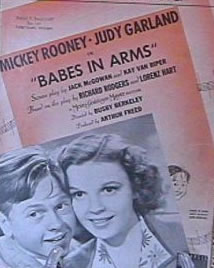
Version 2
Babes in Arms (1939-10-Film)
Type de série: FilmThéâtre: *** Film (*** - ***) Durée : Nombre : Première Preview : 13 October 1939
Première: 13 October 1939
Dernière: 13 October 1939Mise en scène : Busby Berkeley • Chorégraphie : Producteur : Star(s) : Commentaires longs: Older TV prints (and early video releases) of Babes In Arms run 91 minutes, and exclude the "My Day" segment of the finale, with Mickey Rooney and Judy Garland spoofing Franklin and Eleanor Roosevelt. This segment was deleted for a 1948 reissue. "My Day" was restored in the 1990's by Ted Turner, and is included in current prints.
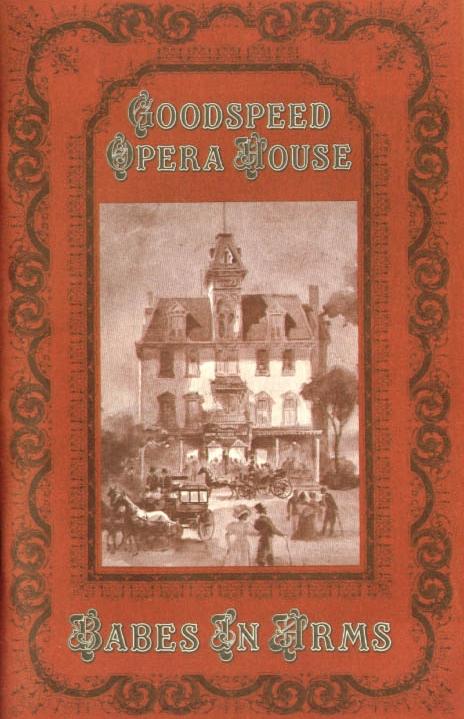
Version 3
Babes in Arms (1979-04-Goodspeed Opera House-East Haddam)
Type de série: RevivalThéâtre: Goodspeed Opera House (East Haddam - Etats-Unis) Durée : 2 mois 1 semaine Nombre : Première Preview : Inconnu
Première: 10 April 1979
Dernière: 16 June 1979Mise en scène : ???? ???? • Chorégraphie : ???? ???? • Producteur : Star(s) :

Version 4
Babes in Arms (1988-08-Open Air Theatre Regent's Park-London)
Type de série: RevivalThéâtre: Open Air Theatre, Regent's Park (Londres - Angleterre) Durée : Nombre : Première Preview : Inconnu
Première: 03 August 1988
Dernière: InconnuMise en scène : Ian Talbot • Chorégraphie : Kenn Oldfield • Producteur : Star(s) : Avec: Jessica Martin (Bunny), Aiden Waters (Gus Field), Damien Thomas (Steve Edwards) , Jane Arden (Terry Thompson), Bryony Glassco (Jennifer Owen), David Henry (Seymour Fleming), Damien Thomas (Steve Edwards), Deborah McCulloch (Susie Ward), Paul Reeves {Valentine White), Adam Price (Don), Sheila Allen (Phyllis Owen)Commentaires : Originally produced in New York April 1937 it was a show with a large cast of teenagers, no stars and modest scenery. It also offered a larger collection of Rodgers & Hart hit songs than any other of their shows. It was a very profitable hit in the USA. However, it waited over 40 years before this, its British premiere. The book was re-written by George Oppenheimer, changing most of the character names and re-arranging the order of some of the scenes. A number of performers whose names were announced in the pre-publicity never actually appeared - though no reason was ever given - and the production itself was roundly condemned for its “stunning awfulness and inanity”. The cast fared no better, described as “universally unable to sing, dance, act or even move on stage with any semblance of adequacy.”
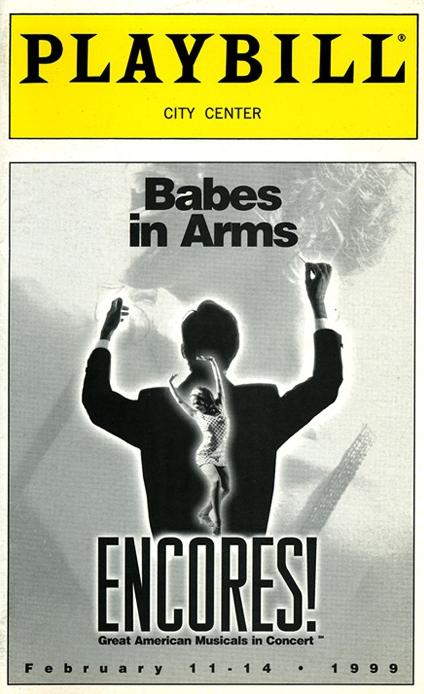
Version 5
Babes in Arms (1999-02-New York City Center-New York) Encores! Concert
Type de série: ConcertThéâtre: New York City Center (Broadway - Etats-Unis) Durée : Nombre : Première Preview : Inconnu
Première: 11 February 1999
Dernière: 14 February 1999Mise en scène : Kathleen Marshall • Chorégraphie : Kathleen Marshall • Producteur : Star(s) :

Version 6
Babes in Arms (2002-08-Goodspeed Opera House-East Haddam)
Type de série: ConcertThéâtre: Goodspeed Opera House (East Haddam - Etats-Unis) Durée : 1 mois 3 semaines Nombre : Première Preview : 12 July 2002
Première: 02 August 2002
Dernière: 28 September 2002Mise en scène : Chorégraphie : Producteur : Star(s) :
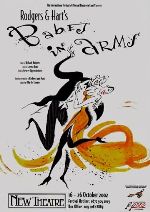
Version 7
Babes in Arms (2002-10-New Theatre-Cardiff)
Type de série: RevivalThéâtre: New Theatre (Cardiff - Angleterre) Durée : 1 semaine Nombre : Première Preview : 16 October 2002
Première: 16 October 2002
Dernière: 26 October 2002Mise en scène : Martin Connor • Chorégraphie : Bill Deamer • Producteur : Star(s) : Presse : The Times - Saturday 19th October 2002:
SEVERAL of the tastier offerings in Cardiff’s International Festival of Music Theatre are "concert performances", which must mean that folk in evening dress will be singing Sondheim’s Anyone Can Whistle, Porter's Jubilee and (too expensive and American a show to get the British premiere it merits) McNally and Flaherty's Ragtime. But Rodgers and Hart's Babes in Arms is receiving the full treatment.
That's to say, the decor is up to British touring if not Broadway standards, and the cast, though a bit raw, is young, spirited and hugely likeable.
Though the musical dates from the late 1930s, it represents the end of an era, not the start of a new one. And that's ironic, for the plot is supposedly about the theatre's future. The "babes in arms" are the youthful flotsam and jetsam working in a playhouse in Cape Cod, hoping to produce a show introducing New York to a brave new generation.
And how to achieve this? Their triumphant closing number, packed with girls in gold swimsuits, demonstrates how. By wowing the Great White Way with exactly the sort of jaunty show that had been wowing it for two decades. You might almost say that Babes in Arms marks the death-throes of the kind of musical the war and Oklahoma! Would sweep away.
But who cares? If you enjoy escapist 1920s and 1930s musicals, you'll enjoy this. The plot is sappy, key events are ill-motivated, but it's fun, fun, fun. It's fun to meet Rose Owen, the ex-child star who comes from Hollywood to launch a stage career in a doleful saga called The Deep North. It's fun to see this play's pretentious Southern author made to look a fool by the "babes in arms" when he dons a Davy Crockett hat and spouts lines about “facing the perils of the wind and snow". It's fun when, in a preposterously curt denouement, everything thespian and romantic turns out well.
The songs include Babes in Arms itself, Johnny One Note, My Funny Valentine, The Lady is a Tramp, which in its proper context is what it should be, a ode to freedom and wanderlust. With the delightful Alexandra Jay singing that, and Alicia Davies, Joshua Dallas, Simon Coulthard and Tiffany Graves also making quite an impression, I don't see why Martin Connor's production shouldn't go far.

Version 8
Babes in Arms (2007-05-Festival Theatre-Chichester)
Type de série: RevivalThéâtre: Chichester Festival Theatre (Chichester - Angleterre) Durée : 1 mois 1 semaine Nombre : Première Preview : Inconnu
Première: 29 May 2007
Dernière: 07 July 2007Mise en scène : Martin Connor • Chorégraphie : Bill Deamer • Producteur : Star(s) :
Pas encore de video disponible pour ce spectacle